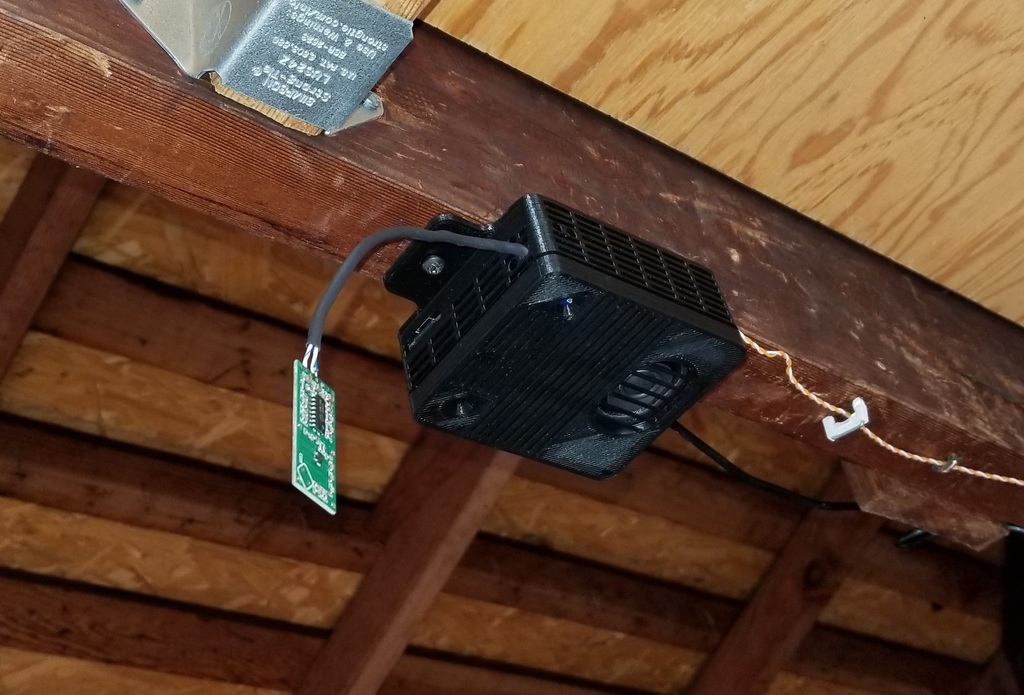
Smarthome Multisensor V2
thingiverse
I made some exciting upgrades to my "garage all-in-one" smart home device. I had to create a new enclosure for it, so here's the list of parts I used in this project: Wemos D1 Mini: https://www.amazon.com/gp/product/B081PX9YFV/ref=ppx_yo_dt_b_asin_title_o06_s00?ie=UTF8&psc=1 12mm 5V Buzzer (add a small NPN transistor or FET to drive it at 5V): https://www.amazon.com/gp/product/B01N7NHSY6/ref=ppx_yo_dt_b_asin_title_o01_s00?ie=UTF8&psc=1 AMS1117 3v3 Supply: https://www.amazon.com/gp/product/B0778KR6FZ/ref=ppx_yo_dt_b_asin_title_o03_s01?ie=UTF8&psc=1 MT3608 DC-DC Boost Supply: https://www.amazon.com/gp/product/B081JJDD7J/ref=ppx_yo_dt_b_asin_title_o06_s00?ie=UTF8&psc=1 RCWL-0516 Microwave Motion Sensor: https://www.amazon.com/RCWL-0516-Detection-Microwave-Detector-Distance/dp/B07MTWZDQZ/ref=sr_1_2?crid=MD3YKDT8XHET&dchild=1&keywords=rcwl-0516&qid=1585527400&sprefix=rcwl%2Caps%2C200&sr=8-2 BH1750 Luminance Sensor: https://www.amazon.com/HiLetgo-GY-302-BH1750-Intensity-Illumination/dp/B00M0F29OS/ref=sr_1_1?dchild=1&keywords=bh1750&qid=1585187244&sr=8-1 BME280 Temp, Humid, and Pressure Sensor: https://www.amazon.com/KeeYees-Temperature-Humidity-Atmospheric-Barometric/dp/B07KYJNFMD/ref=sr_1_3?dchild=1&keywords=bme280&qid=1585596248&sr=8-3 DFPlayer Mini: https://www.amazon.com/Anmbest-YX5200-DFPlayer-Supporting-Arduino/dp/B07JGWMPTF/ref=sr_1_2?dchild=1&keywords=dfplayer&qid=1585187409&sr=8-2 5W Mini Speaker: https://www.amazon.com/CQRobot-Speaker-Interface-Electronic-Projects/dp/B0822YL2L2/ref=sr_1_14?dchild=1&keywords=5w+speaker&qid=1585187244&sr=8-1 I secured the speaker, BME280, and BH1750 in the lid, while the rest of the devices went into the main box. I used melt-down pins and PCB rails to secure most of the devices permanently. The beeper was secured with a press fit, but you can use glue or a hot screwdriver for added security. It's easier to solder all wires to the boards first before mounting them in the box. Once everything is wired up, the lid simply snaps into place. The square hole on the left side fits most micro USB ends, and the 4mm holes on the sides allow you to pass wires through for the RCWL and relay devices. Two access holes are placed on the front and rear of the box for the MT3608 adjust pot and Wemos reset button. A note on wiring: To maximize efficiency and reduce noise, connect the 5V pins from the Wemos to the step-up converter, relay power input, 3v3 regulator, beeper, and DFPlayer. Connect the 3v3 regulator to the lum and BME280 sensors, while the RCWL gets 11V from the step-up converter and puts out 3v3 on its output pin, just like the DFPlayer.
With this file you will be able to print Smarthome Multisensor V2 with your 3D printer. Click on the button and save the file on your computer to work, edit or customize your design. You can also find more 3D designs for printers on Smarthome Multisensor V2.
